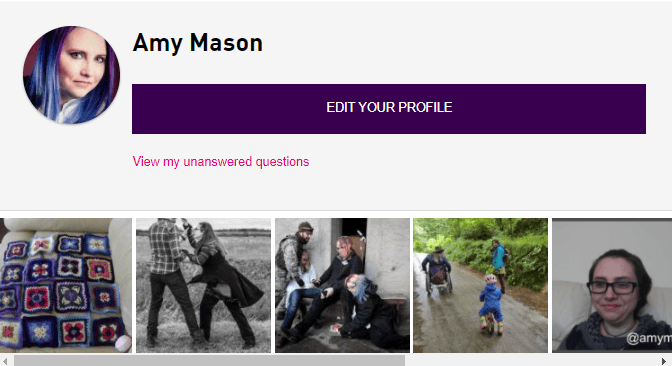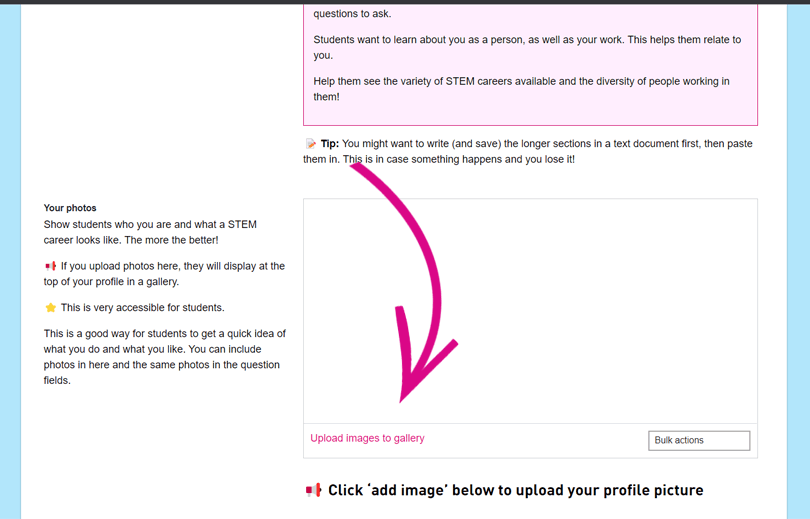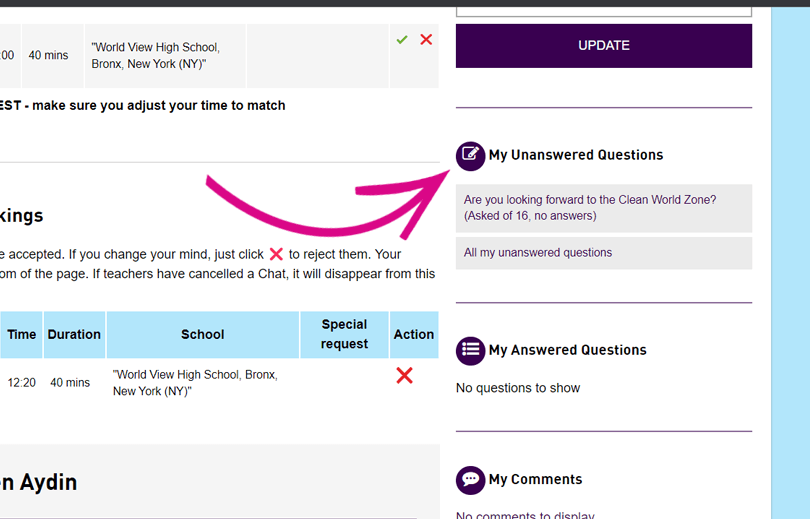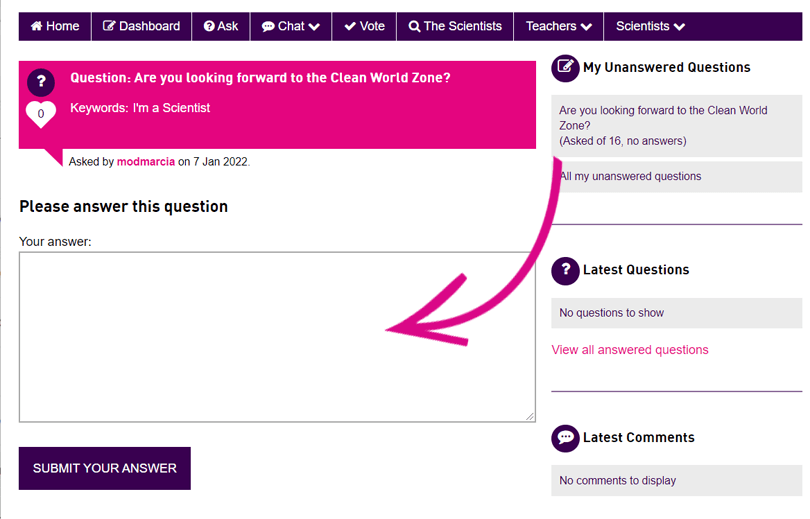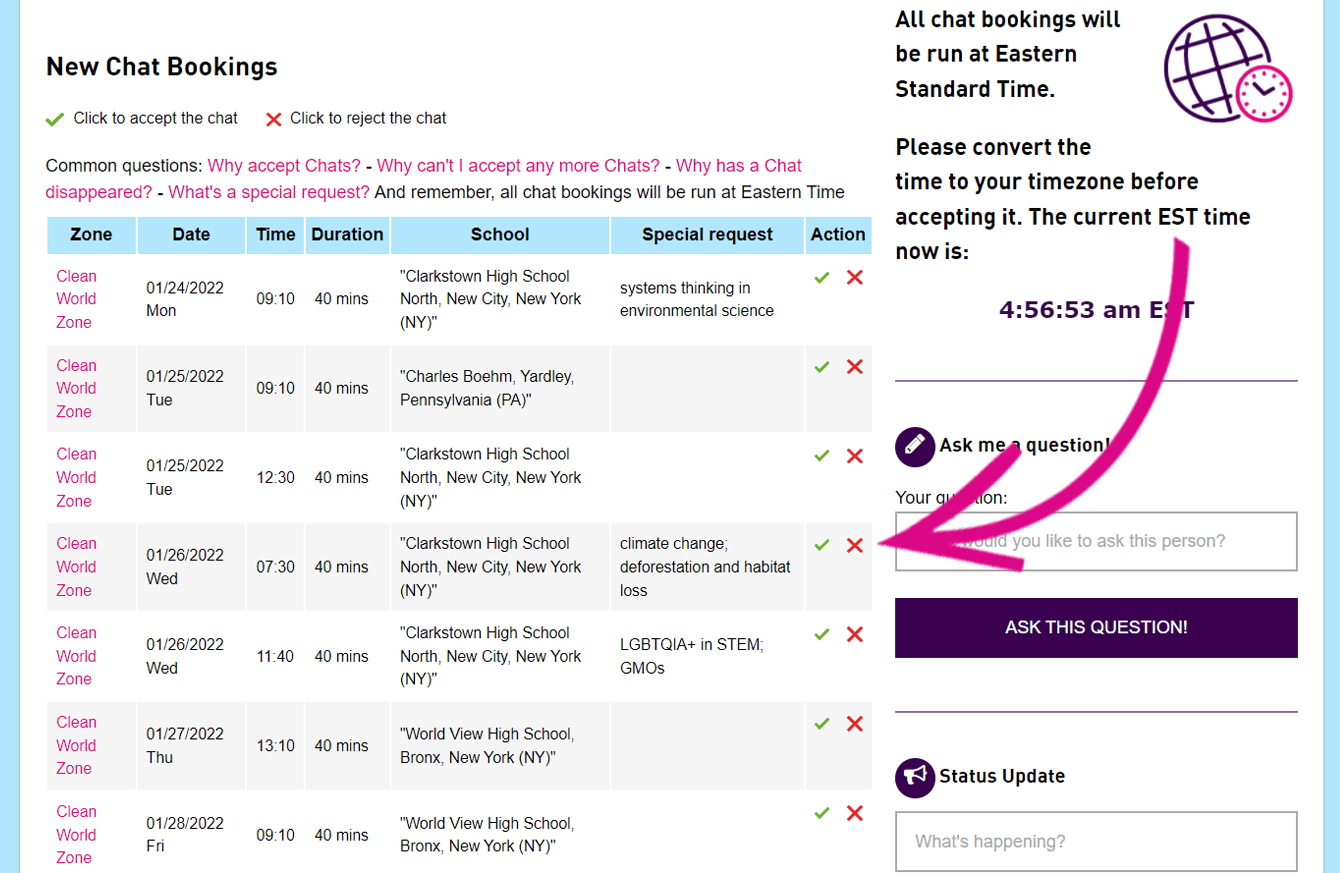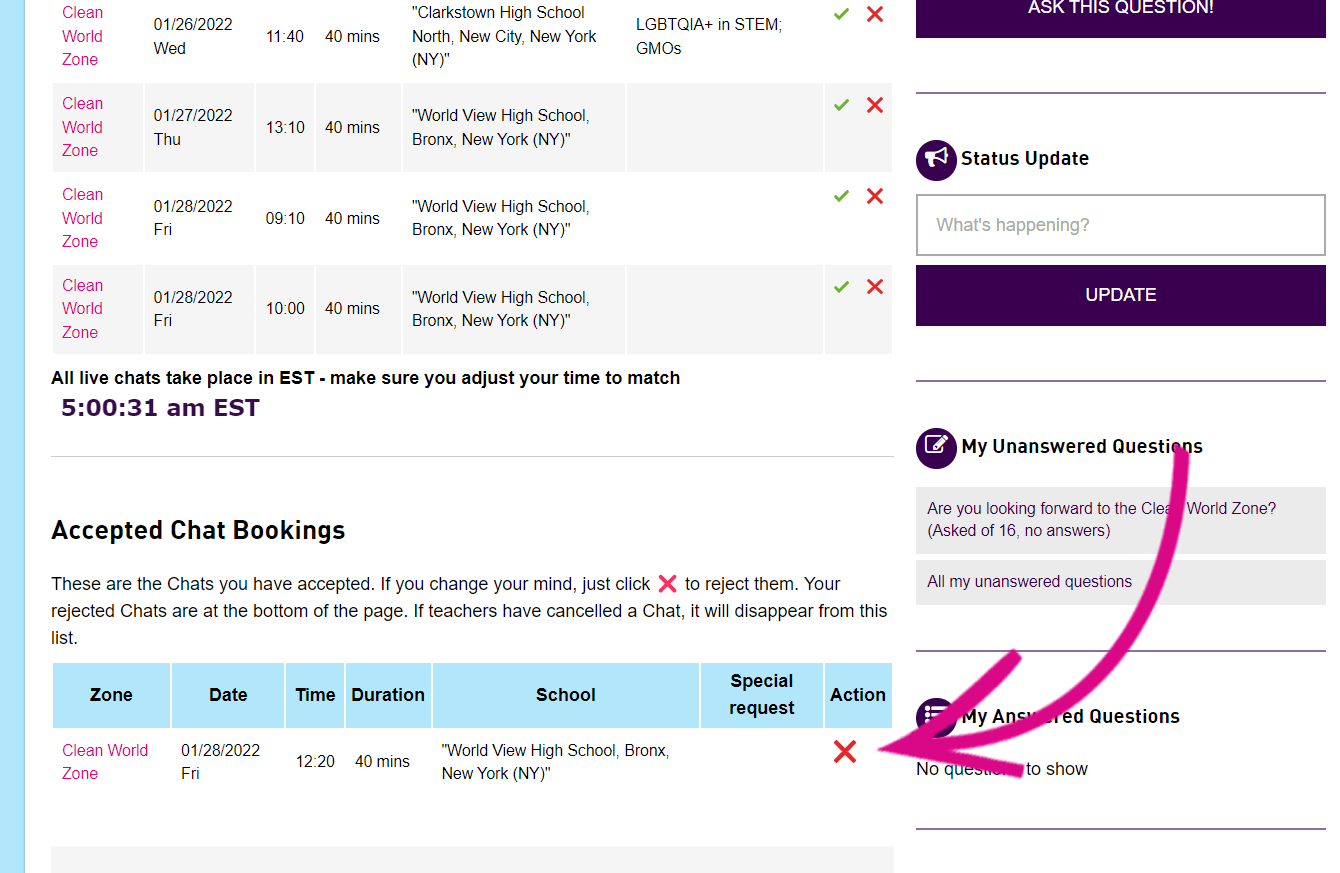These notes will help you find your way through I’m a Scientist.
Any questions, or issues not covered, please email support@imascientist.us
Contents:
Introduction
I’m a Scientist is an online activity that helps school students stay connected with science, their teachers, and their classmates.The activity gets young people talking to working scientists online, to learn about STEM careers and science in the real world. It goes deeper than ‘flash-bang-wow-inspiration!’. Students have fun but also get beyond stereotypes, learn about how science relates to real life, develop their thinking and discussion skills, and make connections with scientists.
You also get to find out the students’ opinions on science, research and society and get them thinking about how this affects their daily lives. All you need to take part is a computer with an internet connection.
Ultimately, it’s about helping all students, whoever they are, feel that science can be something ‘for them’. Read more about the philosophy of I’m a Scientist UK and the concept of Science Capital ❯
Ways to interact with students
You use this site to connect with young people (typically aged 9–18) at schools across the US. You answer their questions about your day to day work, your career, your hobbies and interests, and just about anything else the students can think of!
There are four parts to the site:
- Your Profile where students get an insight into who you are and what you do.
- Students Ask questions which you can answer in your own time; the sooner the better.
- You Chat with school students online in live, energetic, text-only chats.
- Students Vote for their favorite scientist to win $500 to fund their own STEM engagement plans (if your Zone features voting – not all do).
Log in and get started
You should have received your username and login instructions by email. If you have not received these, please get in touch with us.
If this is your first time taking part, you will need to create a password to set up your account ❯
When you log in, you’ll be taken to your Dashboard. This is where you will see questions you’ve been asked and upcoming live chat bookings. From here you can also edit your profile.
You can navigate back to your Dashboard by clicking Dashboard, or clicking your name in the top right-hand corner.
Your profile
You have a profile which includes photos, information about you and your work, interview style questions and a small work history section.
Your profile enables the students to find out more about you, which helps them relate to you.
It’s really helpful if you fill in your profile as soon as possible. It typically takes 20 to 30 minutes to complete. And make sure you add as many photos as you can, but make sure if it’s of your workplace you have permission to do so.
To edit your profile: log in and go to your Dashboard. Click Edit your profile.
Writing your profile
Feel free to add as many pictures as you like to your profile. Images are very accessible to students with lower literacy, and quickly shows them what a career in STEM looks like.
Upload photos to your gallery from the ‘Your Photos’ section, they will then display as a gallery on your Dashboard for students to look through. We also encourage you to add images throughout your page in your answers – you can use the same photos if you like, to explain what they’re about.
You can also embed videos. Please note some schools’ will block YouTube and many other video hosting sites. This isn’t necessarily a reason to avoid videos, as they can be very effective, but don’t make understanding your profile dependent on viewing a video, as it will leave out some students.
For some questions you’ll be asked for a one sentence summary, and then a longer version. The short versions are always displayed for students. The longer versions are displayed if students click ‘read more’. This is for accessibility: testing showed this makes it much easier for students with lower literacy to read profiles, whilst allowing students with a higher literacy to access more detailed answers.
Don’t feel you need to write a lot, even for the longer versions. People reading online tend to prefer shorter texts; a short paragraph will be fine to give people ideas of what to ask you.
Note on social media accounts: Please do not add links to personal social media accounts (e.g. Twitter handles, Instagram). This helps keep the school students’ interactions with you during the activity in a fully moderated space, i.e. this website.
Tip: When filling out your profile remember to save regularly by clicking Update Profile at the bottom of the page.
Answering Follow-up questions
You will be notified by email of new Follow-up questions in the Ask section. You can answer them in your own time, but the sooner the better.
To answer Follow-up questions:
- Log in
- Go to your Dashboard and find the ‘My Unanswered Questions’ section
- Select a question and type your answer!
You will also be able to view other scientists’ answers. It is up to you which questions to answer and how much detail to go into.
Some questions will have been asked to all the scientists in the Zone, but some may have just been asked to you.
Our advice is simple: Be honest, straightforward and use clear ‘plain English’ in your answers.
More advice for engaging and writing
Questions about coronavirus
We expect many questions about coronavirus like ‘How does covid infect people?’ and personal ones like ‘How are you coping?’.
Further guidance for answering questions on coronavirus ❯
Moderation of questions: Our policy
All Follow-up questions sent in the Ask section are moderated by our team before they are sent to you. The moderators work very hard to strike a balance between making your lives easier as participants, and giving students the chance to ask the questions they want answered.
Remember most students taking part are aged between 9 and 18. Some classes are from Community colleges, special classes and non-mainstream educational settings.
We know that you will get sent some very similar questions (believe us, we weed out a lot more of them!). If we’ve let a similar question through it’s because our moderators feel it raises additional, or slightly different points.
Moderators will remove any rude or offensive questions (there are generally very few), but they will allow challenging questions, as well as irreverent but friendly questions.
If there are questions you’re not sure about answering, please contact us.
Live chats
Teachers can book live Chats for their classes on weekdays whilst the activity is running. These are typically booked during school hours, i.e. 9am to 3pm EST.
- All live chats will be booked in Eastern Standard Time, so make sure when you accept a live chat, you convert it to your own timezone
- Live Chats are consistently the most popular part of the activity for students, teachers and scientists.
- They are text-only, instant messaging-style interactions, typically lasting 40 minutes.
- There will always be a member of our moderation team present to ensure live Chats run smoothly.
Live Chats are fun, often lively and energetic. They provide an immediate connection between scientists and students, allowing students to relate to you.
Many teachers tell us that due to the text-only nature of the Chats, quieter students are more active than they would be in a face-to-face interaction, providing an interesting change to class dynamics.
In the screenshot below you can see a number preceding the students username, this shows you how many times a scientist has clicked ‘reply’ to one of their questions.
Managing Chat bookings
Check your Dashboard regularly to see upcoming live Chats that teachers have booked for their classes.
‘✔ Accept’ a booking to let students and teachers know that you can attend.
‘X Reject’ a booking if you can’t make it, you can change your mind later if you become available, unless the chat fills up with other scientists, then it will be removed from the list.Live Chats listed under ‘New Chat Bookings‘ can still accept more scientists. If a Chat disappears from this view, it means enough scientists have now signed up to it.
There is a maximum number of Chat bookings you can accept at one time. Once you have reached this limit, you will not be able to accept any more. Don’t worry! Take part in some live Chats, then come back to accept some more.
If you have accepted a live Chat, and it disappears from your ‘Accepted Chat Bookings‘ list, this means the teacher has had to cancel the booking.
There is no minimum (or maximum) number of live Chats you should take part in over the course of the activity. Just accept the Chats that fit in with your schedule.
Tips for taking part in live Chats
- All live chats are booked and take place in Eastern Standard Time, make sure you convert this to your time so you don’t miss the chat.
- Chats can be hectic, but also exhilarating. Enjoy the bustle and don’t worry too much about your spelling!
- Don’t make assumptions about how much science the students know based on their age. Age isn’t a good indicator of prior knowledge; try and judge this yourself from what the students are saying.
- To help you prioritise questions, the numbers next to each student’s username are how many times they’ve been answered. If you see a ‘0’ or ‘1’, these students may appreciate your next answer most. (see the live chat screenshot above).
- If the chat is going a bit fast, click ‘Show messages’ in the top-right of the chat window. This will show you only the messages directed at you, to help you focus on relevant questions.
- Users with a mortarboard icon next to their username are teachers.
- Click ‘Reply’ next to a student’s message to answer them. Otherwise they may not realise you’ve answered their question, and keep asking it.
- Be patient. Young people’s turn of phrase and use of language will be very different from academic discourse. It may take you a little while to understand what they are trying to ask.
- Be tolerant. Sometimes young people can be over-exuberant online. Chat with them and they will often calm down and engage with you.
- Don’t take offence. Sometimes you will receive questions which seem blunt, but usually students don’t mean to be offensive. The benefit of an online activity is that they feel empowered to ask questions they wouldn’t normally ask.
- If you have any issues, let your chat moderator know or contact us.
Prize money, rewards and recognition
We know you’re not doing this activity for the glory. However, we still want the time you’re giving to connect with students to be appreciated.
Prize money for your project
This information is only relevant for Zones which feature voting and winners – not all do. Please check whether your Zone features the ‘Vote’ icon.
Students are voting for the scientist they think should win $500 for their own public engagement ideas. The winner is the scientist who received the most votes by students overall.
This could be school visits, science fair exhibits, videos or podcasts, blogs, arranging class visits to your lab or office… as long as it’s involving people outside of science, it’s a good idea.
During Zones that feature voting, the scientist with the most Votes that week is announced every Friday. The overall winner is revealed on the final Friday afternoon.
Check out how past winners in I’m a Scientist UK have spent their money ❯
You can take the Vote part of the activity as seriously as you like. There’s no pressure on you to push for votes and no negative consequences for not winning. We never publish the number of votes.
For students though, considering who to vote for is an important part of the activity. It gives students a reason to think critically about the work scientists do, and deepens their involvement in the activity. Please keep this in mind if you’re asked ‘Why should we vote for you?’.
Participation certificates for all
After your Zone we will send you a certificate as a record of your efforts in engaging students with science.
Most of all, whatever time you can give to the activity, you have the thanks of teachers and families across the US. On their behalf, thank you! 🙌
Advice on engagement and writing
Be yourself
Our best advice is to be yourself in your answers. You don’t need to pretend to like Beyoncé/Justin Bieber/Taylor Swift for young people to relate to you, being genuine is what’s important.
Be friendly
When we asked people what they would do differently if they did it again, one answer that summed up many was, “I would be less formal and more personal from the start”.
De-technify your language
Even if you think you are using easy-to-understand language, you likely work in an environment where there is a lot of jargon. Technical words are often used when more accessible ones are available. It’s easy not to realise when your language may be going over the heads of most 13 year olds (and adults).
Don’t “identify”; “find”. Don’t “utilise”; “use”. Don’t “investigate”; “look at”.
Read our full article on writing clearly for I’m a Scientist ❯
Here’s a great video from the Wellcome Trust, which might also help:
When you talk about science, are you sure the words you are using don't mean something different to others? Here are five examples of scientific lingo to use with caution ❗️ pic.twitter.com/kV24VmqtGA
— Wellcome (@wellcometrust) August 28, 2018
Tips on taking part
1. Fit the activity around your schedule
The activity is very flexible. Depending on your schedule, you might take part in 3 live chats in one day, or 2 live chats over a week. That’s completely fine; there are plenty of scientists taking part to share out the load.
Plus students’ questions in the Ask section can be answered whenever you like.
2. It’s not a seminar for super-smart scientists of the future
There will be a wide variation in the students taking part and a big variation in ability. Some will be “gifted and talented” students, some will be lower ability classes, or have additional educational needs. The point of the activity is to provide a space that engages all students, not just the ones who might go on to study STEM subjects at university.
Most teenagers won’t grow up to be scientists, researchers or engineers, but they will all grow up to be people. As adults they’ll have to make decisions about science and engineering — as voters, as consumers — and we are trying to help them develop the skills and confidence to do that.
For some, “Where do boogers come from?” or, “Do you like your job?” may be the most pressing question they can think of. Part of the point is that this activity humanises science for young people; they realise that you are “regular people” who they can relate to.
3. Don’t be afraid to say “I don’t know”.
You will be asked some questions which are not in your area. Answer what you feel you can, but don’t feel you have to Google all evening to answer these questions.
Part of the point of the activity is that students get more realistic ideas about scientists. They can learn that, for example, there’s no reason why a psychologist should know about how much the moon weighs. This makes STEM seem a lot less intimidating. You can be a scientist without being a genius who knows everything! This can be a liberating realisation for students.
Also, of course, many things in science aren’t known. Otherwise there’d be nothing for scientists to do. And even as adults, we can learn new things all the time. This is part of the fun of science! Don’t be afraid to let students in on that secret.
4. Get your boss onside and your colleagues involved!
We’d strongly advise you to tell your boss you are taking part in the activity, and get their support, if you can. Several participants said that this made a big difference. Questions on the website can be answered during the evening, but live chats have to be during the school day, likely during working hours.
Also, many people find themselves discussing some of the more intriguing questions with colleagues. This can be one of the most stimulating things about the activity. Get your colleagues involved in the fun, send them the application page ❯
If you need ammunition to persuade your boss of the benefits, we suggest the following points:
- You’re giving something back and contributing to science education and the future of science and engineering.
- Taking part in I’m a Scientist develops your communication and public engagement skills. This is the most mentioned benefit from taking part.
- It can re-energise you about your own work and get you thinking differently. Students can ask amazing, insightful questions.
- It can broaden your relationships with other scientists and engineers. It’s easy sometimes to get stuck in your specialism. People in previous Zones have learnt, or been reminded of many other parts of science. Some even form collaborations (or friendships) with scientists and engineers in other areas who they met during I’m a Scientist.
Contact us
Please let us know if you’re having any issues. You can email us at support@imascientist.us.
You can also connect with us on Twitter at @imascientist and with the hashtag #IASUS.
The small print
By accepting your invitation to I’m a Scientist you are agreeing to these terms and conditions ❯
We think you’ll agree with them, but it’s best to be sure, so please have a read.


